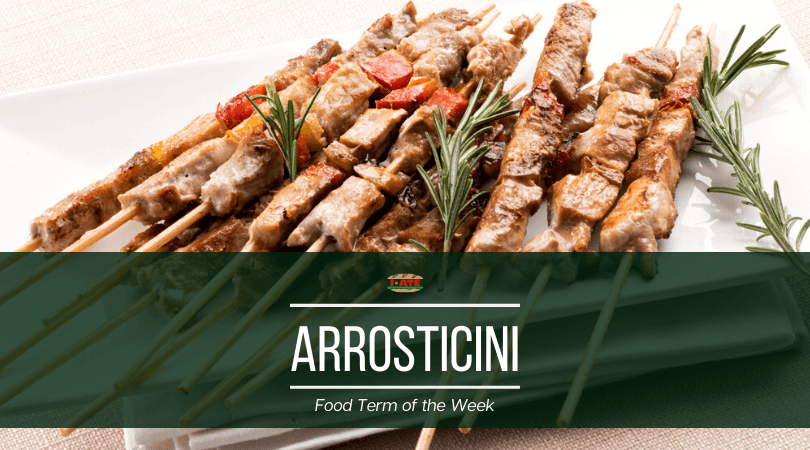Arrosticini are a true emblem of the culinary tradition of Abruzzo, a region in central Italy stretching between the Appennines and the Adriatic Sea. The original indigenous name of this dish is rustill, rostell or arrostell, all dialectal variants of the Italian word arrostelli, which in the 1960s converted into arrosticini, following the commercial Italianisation of the product.

Although they are apparently simple meat skewers, Abruzzo’s arrosticini are the result of a long history and of a specific culinary tradition. They most likely date back to the end of the 19th century, born as shepherds’ food during transhumance and therefore considered an ancient, “poor” and pastoral dish, still to be found today in the mountainous and hilly areas of the region. As the term suggests, these skewers are roasted over a charcoal brazier – never on the electric grill – which is one of the typical features of their preparation. Also the brazier, called fornacella or canalina, is very peculiar with its characteristic elongated canal-shaped form. Without this method of cooking and equipping, it is very difficult to obtain the typical arrosticini flavour. Moreover, what makes them different from other skewers commonly available in Italy is the type of meat used and the way in which it is cut. The original version of Abruzzo’s arrosticini is the one that uses sheep meat or mutton. In the handmade variety, the most valued, the meat is cut with a knife into irregular chunks of various sizes, and layers of very lean meat are interspersed with small pieces of sheep fat, which help the meat resist cooking while remaining soft and succulent. Those of industrial manufacture, on the other hand, are easily recognisable because they are mass-produced and perfectly cut into 1 cm cubes, but are still very good. In recent years, even liver arrosticini have begun to spread. In this case, the piece of meat is mingled with a laurel leaf or a slice of onion to make the meat taste less strong.

Arrosticini cool very quickly, so they are never served in plates or trays: to keep them warm they are brought to the centre of the table in bundles of about 20-40 pieces – depending on the number of diners – wrapped in tin foil or in special terracotta containers, just like bunches of flowers. The only side dish to arrosticini is homemade bread toasted on the same brazier and seasoned with salt and extra virgin olive oil from Abruzzo. As a drink, a good Montepulciano d’Abruzzo, the region’s red wine, is preferred or, as still in use in more traditional trattorias, some red house wine diluted with soda (gassosa). The usual serving for a hungry stomach is ten pieces – fifteen for very strong appetites – but there are stories of legendary creatures that have taken out as many as 140 of them at once.
Last but not least, mind the way you eat them! Don’t even think of using a fork in the clumsy attempt to pull the meat off the stick, but simply rely on your teeth: hold the skewer with your right hand, grip a piece of meat firmly with your teeth and simultaneously draw the stick towards the right. Repeat the procedure for each chunk of meat. Don’t worry about looking too wild or getting your face dirty and greasy, because that’s the traditional way!
It is also customary to cook and consume the arrosticini outdoors, surrounded by nature on excursions, trips to the mountains or similar situations. They are likewise popular in country fairs and festivals as a juicy and practical street food. Nowadays, thanks to large-scale marketing, this typical Abruzzi dish has become a highly sought-after street food from Rome to Milan, as well as in London and New York. But for the raw material and the equipment, the preparation and the way in which they are cooked and served, the best place to taste arrosticini is definitely Abruzzo. Don’t forget to bring a nice bunch of friends, the ultimate ingredient for a perfect arrosticini night!
References and Recipes:
Gli arrosticini abruzzesi, storia di gusto e passione. Visitare Abruzzo. Available at: https://www.visitareabruzzo.it/gli-arrosticini-abruzzesi-storia-di-gusto-e-passione/
La Storia. Arrosticini Online. Available at: http://www.arrosticinionline.com/storia.html
La Verita’, Vi Prego, Sugli Arrosticini… Roseto. Available at: https://www.roseto.com/scheda_news.php?id=10645&tipo=rosetano
Gli Arrosticini. Abruzzo Vivo. Available at: https://www.abruzzo-vivo.it/gli-arrosticini/
Arrosticini: specialità abruzzese. Una Favola Al Contratio. Available at: http://unafavolaalcontrario.it/post/arrosticini-specialita-abruzzese
Arrosticini Abruzzesi | Traditional Lamb Skewers from Abruzzo. Vincenzo’s Plate. Available at: https://www.vincenzosplate.com/recipe-items/arrosticini/
Written by Raffaella Sciarra, PhD in “European Languages and Specialized Terminology” at the University of Naples “Parthenope” (Italy)

